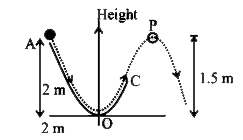Assertion: Frog has a fish-like tadpole larva in its life history
Reason: Ontogeny repeats phylogeny.
If both Assertion and Reason are true and the Reason is the correct explanation of the Assertion
If both Assertion and Reason are true and the Reason is not the correct explanation of the Assertion.
If Assertion is true but the Reason is false.
If both Assertion and Reason are false.
The correct Answer is:A
Step-by-Step Solution:
1. Understanding the Assertion: The assertion states that "Frog has a fish-like tadpole larva in its life history." This means that during its early developmental stage, a frog exhibits characteristics similar to those of fish.
2. Understanding the Reason: The reason provided is "Ontogeny repeats phylogeny." Ontogeny refers to the development of an individual organism from the embryo to its mature form, while phylogeny refers to the evolutionary history of a species. The statement suggests that the development of an organism reflects the evolutionary stages of its ancestors.
3. Explaining the Connection: The assertion can be explained by the reason. Frogs, as amphibians, evolved from fish-like ancestors. During the tadpole stage, frogs exhibit features that are reminiscent of their fish ancestors, such as a tail and gills. This aligns with the concept of recapitulation theory proposed by Ernst Haeckel, which states that the development of an organism (ontogeny) mirrors the evolutionary history (phylogeny) of that organism.
4. Conclusion: Both the assertion and the reason are true. The reason correctly explains the assertion. Therefore, the answer to the question is that both statements are true, and the reason is the correct explanation for the assertion.
Final Answer: Both the assertion and reason are true, and the reason is the correct explanation of the assertion.
---
Topper's Solved these Questions
- EVOLUTIONBOOK - ICSECHAPTER - EVOLUTIONEXERCISE - COMPETITION CORNER (OBJECTIVE TYPE QUESTIONS) (Multiple Choice Questions (MCQs))
55 Videos
- ENVIRONMENTAL ISSUESBOOK - ICSECHAPTER - ENVIRONMENTAL ISSUESEXERCISE - COMPETITION CORNER (ASSERTION AND REASON TYPE QUESTIONS (FOR AIIMS ASPIRANTS))
9 Videos
- HUMAN HEALTH AND DISEASE BOOK - ICSECHAPTER - HUMAN HEALTH AND DISEASE EXERCISE - COMPETITION CORNER (OBJECTIVE TYPE QUESTIONS) (Assertion and Reason Type Questions (For AIIMS aspirants))
28 Videos
Similar Questions
Knowledge Check
Assertion: Fish meal is a rich source of proteins for cattle and poultry.
Reason: Fish meal is produced from non-edible parts of fish like fins, gills, etc.AIf both Assertion and Reason are true and the Reason is the correct explanation of the Assertion.BIf both Assertion and Reason are true and the Reason is not the Reason is not the correct explanation of the assertionCIf assertion is true but the Reason are falseDIf both Assertion and Reason are falseAssertion: Bone has very hard matrix whereas cartilage has pliable matrix.
Reason: Bone has calcium salts in its matrix whereas cartilage has chondroitin salts in its matrix.AIf both assertion and reason are ture and reason is the corect explanation of assertionBIf both assertion and reason are ture but reson is not the correct explanation of assertionCIf assertion is true reason is falseDIf both assertion and reason are false
Assertion:Frog's tadpole has fish-like form, tail and gills
Reason: Tadpole stage is the recapitulation of the fish-like ancestor of frog in the latter's life history
View SolutionAssertion: The embryos of fish, salamander, tortoise, chick and a man, of same age resemble one another closely.
Reason: Ontogeny recapitulates phylogeny.
View SolutionEvolutionary biology is defined as
(a) Study of history of life forms on earth
(b) Ontogeny recapitulates Phylogeny
(c) Developmental history of embryo
(d) Evolutionary history of an organism
View SolutionAssertion : Frog can change colour according to its surroundings
Reason : It is mimicry to capture preys.
View SolutionA particle (m = 3 kg) slides down a frictionless track (AOC) starting from rest at a point A (height 2m). After reaching C, the particle continues to move freely in air as a projectile. When it reaching its highest point P (height 1.5 m) the kinetic energy of the prarticle (in J) is : Figure drawn is schematic and not to scale , take g = 10ms−2

View SolutionAssertion (A) It is necessary to study life history of an ascidian to consider it as chordate
Reason (R) Tadpole larva of ascidians have a notochord that disappears in the adult
View Solution